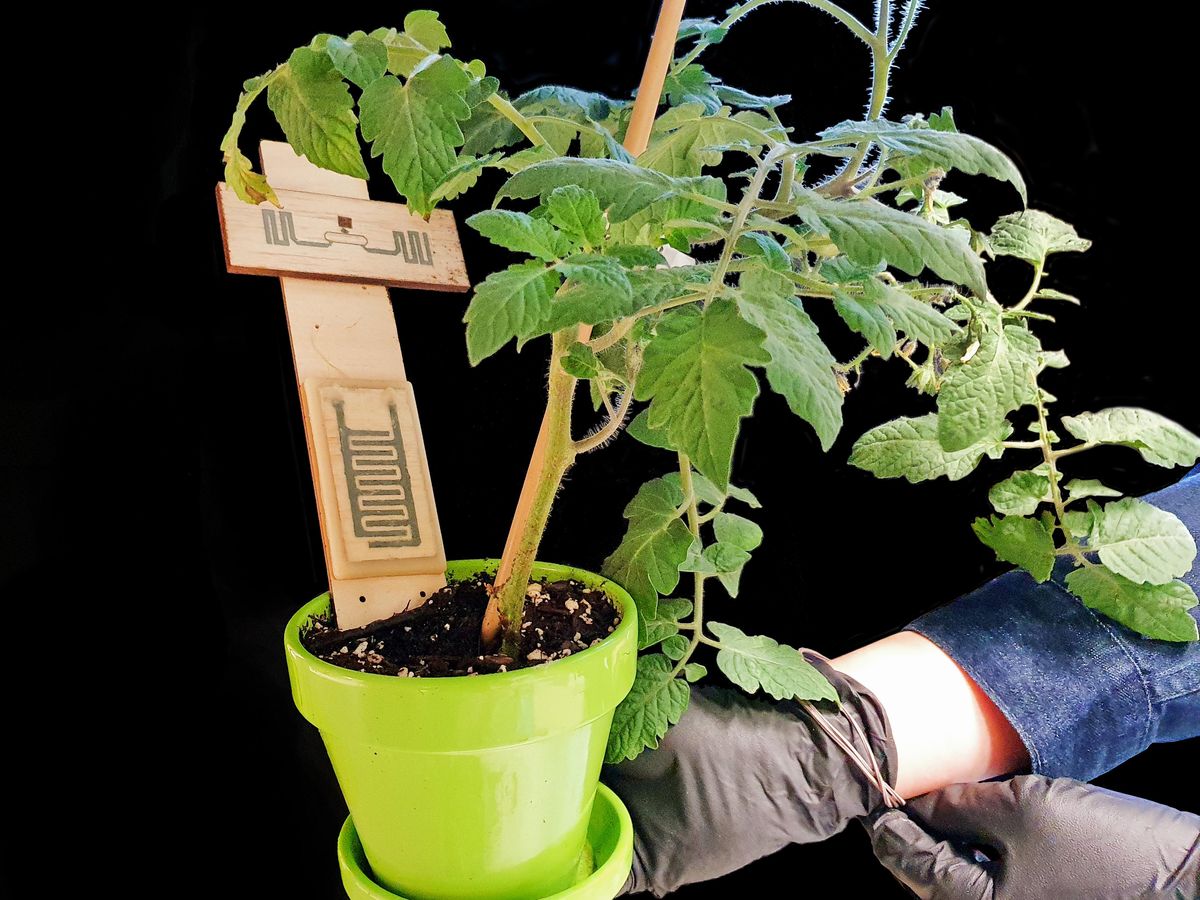Demonstrating that we are truly living in an era of "smart agriculture," many of the technologies showcased in this year's ARPA-E Summit were in the farming sector—most notably, sensors for crops and farmlands. Just like the smart devices that enable us to monitor our health every minute of the day, these agricultural sensors allow farmers to monitor plant and soil conditions close to real-time. Here are two that caught this writer's eyes.
First up is a 3D-printed, biodegradable soil sensor that checks moisture and nitrogen levels. One of the benefits of using print electronics is being able to mass-produce at a low cost, says Gregory Whiting at the University of Colorado, Boulder, one of the principal investigators of the team working on the sensors. "Agriculture is a pretty cost constrained industry," Whiting says, and 3D-printed sensors allow farmers to place many sensors throughout their large farmlands—often hundreds of acres—without spending a ton of money.
And this enables the farmers to monitor soil conditions in greater detail, Whiting says. Depending on factors such as how the sun hits the ground, the amount of water or the fertilizer needed could vary patch by patch. Traditional sensors were too expensive for the farmers to buy in large quantities, and, as a result, the special resolution wasn't high enough to reflect this variability. With the new, cheap sensors, farmers will be able to collect data on their farms without worrying about the variability.
One problem with mass-producing sensors, however, is that it creates a lot of waste. That's why Whiting and his colleagues decided on using biodegradable materials, such as zinc and wood. But this solution also posed a challenge: What if the sensor degrades before the job is done?
Whiting and his team solved this issue by encapsulating the sensor parts using beeswax or soy wax. The protective wax casing ensures moisture and nitrogen sensing parts, made from zinc, to operate properly for the desired amount of time, typically a few months until the crops fully grow. And by the end of that period, the casing would start to break down, and the sensor would degrade.
Whiting says that the sensor signal will be transmitted via long-range RFID—like those used in toll roads—collected using a drone or farm equipment with a reader attached. The team is currently testing the sensors in a greenhouse. By 2022, they plan to move out to a field. "Building electronics made of zinc and wood and waxes—it's just very weird and cool," Whiting says.
The other sensor that was also notable amongst those presented in this year's ARPA-E Summit was a zero-power infrared sensor detecting a plant's thirst. This sensor, developed by Matteo Rinaldi and his team at Northeastern University, shines infrared light on the leaves of a plant. By reading the reflected light, it can tell if the plant is dehydrated or not.

The idea to use infrared light stemmed from Rinaldi's previous project: detecting exhaust fumes from cars. By shifting the detection range to match the reflection signal from the moisture of plant leaves instead of the exhaust fumes, the team was able to reinvent their technology for agricultural use. With this shift, "whatever changes in reflectance [are] depending only on water stress of the plant and nothing else," says Antea Risso, a graduate student working on this project. "So, it's quite reliable."
One of the biggest drawbacks of the soil sensors is the need for calibration, Risso says. Even within a single farm, there could be many different types of soil present, and calibrating the sensors accordingly could take up a lot of time. The plant sensor would only have to be calibrated by the plant type, which is minimal compared to the soil sensor, Risso says. In addition, reading the moisture level directly from the plant assesses its health more accurately, which is ultimately what the farmers care about.

The sensor uses energy only when the infrared signal indicates that the plant is dehydrated. When the signal with the right wavelength is absorbed by the nanoplasmonic absorbers designed and engineered by Rinaldi's team, the temperature of the device increases, and that causes the device to bend, turning on the power switch. Because the switch is expected to be on only seldomly, Rinaldi says their sensors will last about 10 years without the need to change batteries.
So far, the team has tested their prototypes in the lab environment. By the end of this year, Rinaldi says the team will test a portable prototype in an actual field. At the same time, Rinaldi is already taking steps to commercialize the technology. He and Zhenyun Qian, a research assistant professor at Northeastern, co-founded Zepsor Technologies, aiming to bring the technology into the market.
"There are a lot of precision-oriented agriculturists [who] are very, very interested in this," Risso says. "So, we are hoping to test it sooner with their collaboration."
- The Promise of Precision Agriculture in Drought-Ridden California ... ›
- John Deere and the Birth of Precision Agriculture - IEEE Spectrum ›
- Stress Monitors for Plants Can Spot Dehydration - IEEE Spectrum ›



